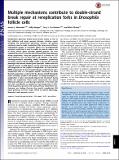| dc.contributor.author | Beagan, Kelly | |
| dc.contributor.author | McVey, Mitch | |
| dc.contributor.author | Alexander, Jessica Lynne | |
| dc.contributor.author | Orr-Weaver, Terry | |
| dc.date.accessioned | 2017-05-11T19:12:42Z | |
| dc.date.available | 2017-05-11T19:12:42Z | |
| dc.date.issued | 2016-11 | |
| dc.date.submitted | 2016-07 | |
| dc.identifier.issn | 0027-8424 | |
| dc.identifier.issn | 1091-6490 | |
| dc.identifier.uri | http://hdl.handle.net/1721.1/108854 | |
| dc.description.abstract | Rereplication generates double-strand breaks (DSBs) at sites of fork collisions and causes genomic damage, including repeat instability and chromosomal aberrations. However, the primary mechanism used to repair rereplication DSBs varies across different experimental systems. In Drosophila follicle cells, developmentally regulated rereplication is used to amplify six genomic regions, two of which contain genes encoding eggshell proteins. We have exploited this system to test the roles of several DSB repair pathways during rereplication, using fork progression as a readout for DSB repair efficiency. Here we show that a null mutation in the microhomology-mediated end-joining (MMEJ) component, polymerase θ/mutagen-sensitive 308 (mus308), exhibits a sporadic thin eggshell phenotype and reduced chorion gene expression. Unlike other thin eggshell mutants, mus308 displays normal origin firing but reduced fork progression at two regions of rereplication. We also find that MMEJ compensates for loss of nonhomologous end joining to repair rereplication DSBs in a site-specific manner. Conversely, we show that fork progression is enhanced in the absence of both Drosophila Rad51 homologs, spindle-A and spindle-B, revealing homologous recombination is active and actually impairs fork movement during follicle cell rereplication. These results demonstrate that several DSB repair pathways are used during rereplication in the follicle cells and their contribution to productive fork progression is influenced by genomic position and repair pathway competition. Furthermore, our findings illustrate that specific rereplication DSB repair pathways can have major effects on cellular physiology, dependent upon genomic context. | en_US |
| dc.description.sponsorship | United States. National Institutes of Health (GM57960) | en_US |
| dc.description.sponsorship | United States. National Institutes of Health (GM118098) | en_US |
| dc.language.iso | en_US | |
| dc.publisher | National Academy of Sciences (U.S.) | en_US |
| dc.relation.isversionof | http://dx.doi.org/10.1073/pnas.1617110113 | en_US |
| dc.rights | Article is made available in accordance with the publisher's policy and may be subject to US copyright law. Please refer to the publisher's site for terms of use. | en_US |
| dc.source | PNAS | en_US |
| dc.title | Multiple mechanisms contribute to double-strand break repair at rereplication forks in Drosophila follicle cells | en_US |
| dc.type | Article | en_US |
| dc.identifier.citation | Alexander, Jessica L.; Beagan, Kelly; Orr-Weaver, Terry L. and McVey, Mitch. “Multiple Mechanisms Contribute to Double-Strand Break Repair at Rereplication Forks inDrosophilafollicle Cells.” Proceedings of the National Academy of Sciences 113, no. 48 (November 2016): 13809–13814. © 2016 National Academy of Sciences | en_US |
| dc.contributor.department | Massachusetts Institute of Technology. Department of Biology | en_US |
| dc.contributor.mitauthor | Alexander, Jessica Lynne | |
| dc.contributor.mitauthor | Orr-Weaver, Terry | |
| dc.relation.journal | Proceedings of the National Academy of Sciences | en_US |
| dc.eprint.version | Final published version | en_US |
| dc.type.uri | http://purl.org/eprint/type/JournalArticle | en_US |
| eprint.status | http://purl.org/eprint/status/PeerReviewed | en_US |
| dspace.orderedauthors | Alexander, Jessica L.; Beagan, Kelly; Orr-Weaver, Terry L.; McVey, Mitch | en_US |
| dspace.embargo.terms | N | en_US |
| dc.identifier.orcid | https://orcid.org/0000-0003-4643-2282 | |
| dc.identifier.orcid | https://orcid.org/0000-0002-7934-111X | |
| mit.license | PUBLISHER_POLICY | en_US |
